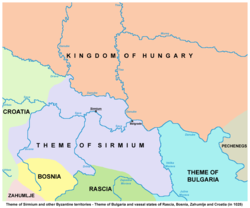Sirmium (theme)
| Theme of Sirmium Θέμα Σιρμίου | |||||||||||||||
|---|---|---|---|---|---|---|---|---|---|---|---|---|---|---|---|
| Theme of Byzantine Empire | |||||||||||||||
| 1018–1071 | |||||||||||||||
 Map of Theme Sirmium within Byzantine Empire in 1045. | |||||||||||||||
| Capital | Sirmium | ||||||||||||||
| • Type | Theme | ||||||||||||||
| Historical era | Middle Ages | ||||||||||||||
• Annexation | 1018 | ||||||||||||||
• Disestablished | 1071 | ||||||||||||||
| |||||||||||||||

The Theme of Sirmium (Greek: Θέμα Σιρμίου) was a Byzantine administrative unit (theme), which existed in present-day Serbia, Croatia and Bosnia and Herzegovina in the 11th century. Its capital was Sirmium (today Sremska Mitrovica).
History
In the 6th century, another Byzantine province existed in this area. It was known as Pannonia and also had its capital in Sirmium, but was much smaller in size.
In the beginning of the 11th century, the area which later became the Theme of Sirmium lay within the borders of the First Bulgarian Empire, under Tsar Samuil and the local duke (voivode) known as Sermon ruled over Sirmium and surrounding area. In a long war, the Byzantine emperor Basil II conquered Bulgaria, and established new Byzantine themes and other local governorates under generals (strategoi) on its territory. The central part of Samuil's realm became the Theme of Bulgaria, the northeastern part the Theme of Paristrion, and the northwestern part became the Theme of Sirmium.
The exact borders of the Theme of Sirmium are unclear: according to some sources, theme included region of Syrmia (on the northern bank of the Sava river) as well as parts of modern Serbia and Bosnia and Herzegovina on the southern bank of the Sava river,[1] while, according to other sources, it extended along the southern bank of the Danube and along the river Sava. [citation needed]
In this time, the name "Syrmia" was used as a designation for territories on the both banks of the river Sava, while later, designations "Syrmia on this side" (in the north of the Sava river) and "Syrmia on the other side" (in the south of the Sava river) were introduced, until finally, the territory in the south of the Sava river received name "Mačva".
| History of Vojvodina |
|---|
|
|
After the battle of Manzikert in 1071 and the resulting turmoil in the Byzantine Empire, the Kingdom of Hungary conquered Syrmia, but Byzantine control over the area was restored under the Komnenian emperors. In the last years of the 12th century, Byzantine power waned, and the emergence of the Second Bulgarian Empire created a new contender for the region's control. Eventually, during the 13th and 14th century, the various Serbian states would succeed in control of the region. One of these states, the Kingdom of Syrmia, was centered in the area in which Byzantine Theme of Sirmium existed.
Strategoi
- Constantine Diogenes, 1018–1029
- Theophilos Erotikos, 1040
- Ljutovid, fl. 1039–1042
See also
References
This article includes a list of general references, but it lacks sufficient corresponding inline citations. (June 2012) |
- ^ Dragan Brujić, Vodič kroz svet Vizantije, Beograd, 2004.
Sources
- Dragan Brujić, Vodič kroz svet Vizantije, Beograd, 2004.
- Dr Dušan J. Popović, Srbi u Vojvodini, knjiga 1, Novi Sad, 1990.
- Petrit Imami, Srbi i Albanci kroz vekove, Beograd, 2000.
- Sve srpske mape - od šestog veka do Pariza, Specijalno izdanje BLICA, decembar 1995. godine.
- Pol Lemerl, Istorija Vizantije, Beograd, 1997.
External links
- States and territories established in 1018
- States and territories disestablished in the 1070s
- History of Syrmia
- Medieval history of Vojvodina
- Medieval Croatia
- Medieval Bosnia and Herzegovina
- Themes of the Byzantine Empire
- States and territories established in the 11th century
- Medieval Serbia
- Byzantine Serbia
